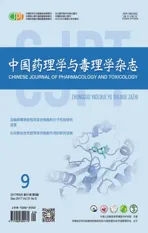有机氯杀虫剂致脂肪酸和胆汁酸代谢异常的研究进展
2017-01-16邵文涛顾爱华蒋兆彦
刘 倩,邵文涛,顾爱华,蒋兆彦
(1.南京医科大学公共卫生学院,江苏南京 211166;2.同济大学附属东方医院胆石病中心,上海 201200)
有机氯杀虫剂(organochlorine pesticides,OCP)是一类以碳氢化合物为基本架构,并有氯原子连接在碳原子上,同时又有杀虫效果的有机化合物。其代表性化合物包括双对氯苯基三氯乙烷(dichlorodiphenyl trichloroethane,DDT,俗称滴滴涕)和六氯环己烷(hexachlorocyclohexane,HCH,俗称六六六),以及二者在环境和生物体中的主要代谢产物p,p’-DDE和β-HCH。OCP曾被广泛应用于农业虫害的防治,从20世纪70年代后期开始被禁用,但检测数据显示,OCP在环境中仍有不同程度的残留[1],包括土壤[2-5]、空气[6-8]和水[9],并可通过吸入或摄入污染的空气、水和食物等途径进入机体[10]。由于OCP具有亲脂性和难降解的特点,易于在体内脂质富集组织蓄积,通过生物富集和食物链放大作用,最终影响高等营养级生物体和人类的健康。我国人群数据显示,OCP在脂肪组织中蓄积含量最高,在非职业暴露人群腹腔脂肪组织中可检测到12种有机氯代谢产物,其中含量最高的是p,p’-DDE和β-HCH,在血清中含量次之[11],尤其值得注意的是,脐带血中仍能检测出较高浓度的OCP[12],提示OCP可经血胎屏障影响子代。
体内蓄积的OCP与一些酶、蛋白质、受体和转录因子相互作用,可导致代谢机制紊乱而产生持续毒效应,如生殖毒性[13]、诱发肿瘤[14]、神经行为障碍[15]和免疫毒性[16]等。近期流行病学证据表明,OCP与代谢性疾病相关,如血清β-HCH含量与人群身体质量指数、腰围、体脂百分比以及腹部皮下脂肪组织总含量均呈正相关[17];血清β-HCH浓度与肝小叶炎症呈正相关,可能与胆汁酸代谢变化有关[18];2型糖尿病患者[19]和动脉粥样硬化患者[20]血清p,p’-DDE含量均增高,可能与OCP慢性暴露增加葡萄糖和脂质代谢紊乱的风险相关[21]。此外,血清高OCP残留还与胆囊结石病的发生呈正相关[22]。这些结果表明,机体OCP残留增加了脂质代谢异常相关性疾病发生的风险。本文就OCP致机体脂质代谢异常的机制进行综述。
1 OCP对脂肪酸代谢的影响
机体内脂肪酸代谢主要通过从乙酰辅酶A开始的脂肪酸合成过程,以及以β-氧化为主的脂肪酸降解过程。脂肪酸含量的增加导致其合成产物甘油三酯和胆固醇酯含量增加。
由于OCP具有亲脂性,脂肪组织是其在体内残留的主要场所。我们检测了胆囊切除术中获取的患者腹腔脂肪中OCP的含量发现:p,p’-DDE和β-HCH是人体内残留的2种主要OCP代谢物。高OCP残留组患者的肝组织脂肪酸含量显著高于低OCP残留组,表现为饱和脂肪酸(saturated fatty acids,SFA)含量升高,不饱和脂肪酸含量降低。这说明OCP暴露会增加人体肝脂肪酸含量。脂肪酸是甘油三酯和胆固醇酯合成的底物,其含量增加对于后二者的增加具有重要意义。我们发现,高OCP残留组患者肝脂肪酸合成酶(fatty acid synthase,FAS)和硬脂酰辅酶A去饱和酶1(stearoyl-CoA desaturase-1,SCD1)表达增加,均高于低OCP残留组患者[23],提示其脂肪酸合成增加。
动物实验结果显示,混合OCP的高脂饮食可促进大鼠肝脂肪变性[24],这种异常与激活转录因子固醇反应元件结合蛋白1c表达进而促进脂肪酸合成有关[25]。利用动物OCP暴露模型研究结果显示,p,p’-DDE暴露可增加大鼠肝棕榈酸、硬脂酸和油酸等脂肪酸含量[26];慢性低剂量 p,p’-DDE 和β-HCH暴露可增加小鼠肝SFA和单不饱和脂肪酸的含量,降低多不饱和脂肪酸的含量,导致肝甘油三酯含量显著增加,肝组织病理切片镜检可见大量脂滴形成。这些异常与OCP上调Fas基因等有关[27]。
线粒体是完成脂肪酸β-氧化的重要细胞器,脂肪酸β-氧化将脂酰辅酶A转化成乙酰辅酶A以及产生ATP[28]。p,p’-DDE暴露减少大鼠肝线粒体数量和ATP水平[29]。我们发现,p,p’-DDE和β-HCH暴露的小鼠肝线粒体结构损伤,脂肪酸β-氧化的关键基因Cpt1α和Mcad等均有不同程度的降低。此外,线粒体损伤还影响三羧酸循环过程,导致延胡索酸和苹果酸产物降低,而柠檬酸经无氧酵解形成乳酸增加[27]。体外研究显示,p,p’-DDE和β-HCH降低肝细胞线粒体数量、线粒体膜电位、氧耗量和ATP水平[27]。因此,线粒体功能障碍导致脂肪酸降解受抑是OCP导致脂质代谢异常的另一个重要机制。
2 OCP对胆汁酸代谢的影响
胆汁酸由胆固醇作为底物在肝细胞合成,和牛磺酸或甘氨酸形成结合胆汁酸被分泌到胆汁并储存于胆囊中[30]。进食后它们被释放到肠道中参与甘油三酯、胆固醇和脂溶性维生素的吸收,进而调节糖脂及能量代谢[31]。胆汁酸的成分及其疏水性是影响肠道胆固醇重吸收的重要因素。在回肠末端,95%的胆汁酸被重吸收回肝,形成胆汁酸的肠肝循环,少量胆汁酸则进入大肠[32]。机体将胆固醇转化成胆汁酸也是清除过多胆固醇、维持机体胆固醇平衡的一个重要调节途径。
在小鼠,p,p’-DDE和β-HCH暴露导致胆汁酸合成限速酶胆固醇 7α-羟化酶(cholesterol 7αhydroxylase,Cyp7A1)和胆固醇12 α-羟化酶(sterol 12α-hydroxylase,Cyp8B1)的表达增加,其产物胆酸含量增加,而影响胆汁酸组分的构成比[35]。Cyp7A1基因的表达受肝法尼醇X受体(farnesoid X receptor,FXR)通路和成纤维细胞生长因子15(fibroblast growth factor 15,Fgf15)通路的负反馈调节[34]。我们发现,p,p’-DDE和β-HCH暴露可引起FXR通路的靶基因Abcb11和Mrp2/3表达增加,但Cyp7A1表达并未受其负反馈调节而降低;而回肠Fgf15基因表达降低时,Cyp7A1表达增加,说明OCP主要是通过Fgf15通路影响Cyp7A1的表达[33]。回肠细胞顶端钠离子依赖性胆汁酸转运体和有机溶质转运蛋白基因表达均降低,说明肠道对胆汁酸重吸收降低[33]。我们发现,体外培养的HepG2细胞OCP暴露后,胆汁酸合成相关基因Cyp7A1,Cyp8B1和胆固醇27α-羟化酶表达增加,结合体内实验可推测,OCP暴露减少胆汁酸在回肠的重吸收,肝细胞代偿性增加胆汁酸合成以维持胆汁酸含量的平衡[33]。不同胆汁酸由于其在甾醇骨架的羟基数量和位置差异,形成了不同的亲水和疏水特性,影响对脂溶性物质的吸收能力[35]。p,p’-DDE和β-HCH暴露的小鼠疏水性胆酸含量增加,亲水性β-鼠胆酸含量降低,使胆酸/β-鼠胆酸比例增加,疏水性增加,进而可促进肠道中胆固醇吸收[36],导致机体肝胆固醇负荷增加。是否在人体也有类似的调节作用目前尚无研究报道。
3 OCP通过肠道菌群影响脂肪酸和胆汁代谢
研究发现,经肠道摄入的环境污染物如农药狼毒素和氟环唑等,可影响肠道菌群的组成和丰度,导致胆固醇和胆汁酸代谢改变[37-38]。肠道中正常的肠道菌群是人体内重要的屏障,同时也是早期接触到经口暴露的外源化学物的“器官”[39]。研究显示,将高脂饲料喂养诱导脂质代谢异常表型的小鼠的肠道菌群移植到无菌小鼠肠道中,可引起后者体质量及肝脂肪含量的显著增加[40]。
肠道菌群的改变可通过以下2方面影响机体糖脂代谢:①直接影响宿主从肠道内容物里摄取能量,造成脂肪的堆积;②改变肠壁通透性,降低紧密连接蛋白表达,导致细菌移位,细菌产物内毒素(即脂多糖)及未消化的外源物质释放到循环系统,血液中脂多糖累积可激发炎症,影响糖脂代谢[41]。有趣的是,p,p’-DDE和β-HCH也可改变肠道菌群的丰度以及结构比[33]。因此,OCP通过影响肠道菌群促使机体糖脂代谢异常也可能是其产生代谢毒性效应的一个重要机制。
肠道菌群也是机体胆汁酸代谢调节的重要环节。肠道菌群中含胆盐水解酶的菌群可将结合胆汁酸分解成游离胆汁酸,后者被含7α-脱羟酶的菌群通过脱羟基作用形成次级胆汁酸,如脱氧胆酸和石胆酸。肠道菌群中含BSH的菌群主要包括拟杆菌(Bacteroides),梭菌(Clostridium),肠球菌(Entero⁃coccus),双岐杆菌(Bifidobacterium)和乳酸杆菌(Lactobacillus)等[44]。p,p’-DDE和β-HCH暴露可增加上述菌群丰度,特别是乳酸杆菌,推测OCP对肠道次级胆汁酸含量的增加作用可能与其干扰上述肠道菌群丰度有关[33]。肠道菌群还可经FXR和胆汁酸膜受体调节胆汁酸的代谢,并影响脂质代谢[43]。因此,OCP不仅直接影响肝胆汁酸合成,还可通过影响肠道菌群,改变次级胆汁酸含量,影响胆汁酸成分。
4 结语
综上所述,OCP通过多渠道多通路导致机体脂质代谢异常,其涉及的可能机制包括:促进脂肪酸合成,影响线粒体脂肪酸β-氧化,导致脂肪酸代谢异常;抑制肠道胆汁酸重吸收,促进肝胆汁酸合成;改变肠道菌群,影响肠道结合胆汁酸水解和次级胆汁酸的形成,从而影响胆汁酸含量,特别是增加胆酸和β-鼠胆酸比例,使之形成利于胆固醇摄取的性状,进而促进脂质摄取导致代谢紊乱。长期OCP蓄积导致的脂质代谢异常可促进相关疾病的进展[27,33],因此,人们应重视环境OCP残留带来的健康危害及其长远效应,适当监测体内OCP残余可能对预防其所致相关代谢性疾病具有重要意义。
参考文献:
[1] Nakata H,Hirakawa Y,Kawazoe M,Nakabo T,Arizono K,Abe S,et al.Concentrations and compositions of organochlorine contaminants in sediments,soils,crustaceans,fishes and birds collected from Lake Tai,Hangzhou Bay and Shanghai city region,China[J].Environ Pollut,2005,133(3):415-429.
[2] Sun J,Pan L,Zhan Y,Lu H,Tsang DC,Liu W,et al.Contamination of phthalate esters,organochlorine pesticides and polybrominated diphenyl ethers in agricultural soils from the Yangtze River Delta of China[J].Sci Total Environ,2016,544:670-676.
[3] Wang B,Wu C,Liu W,Teng Y,Luo Y,Christie P,et al.Levels and patterns of organochlorine pesticides in agricultural soils in an area of extensive historical cotton cultivation in Henan province,China[J].Environ Sci Pollut Res Int,2016,23(7):6680-6689.
[4] Liu Q,Tian S,Jia R,Liu X.Pollution characteristics and ecological risk assessment of HCHs and DDTs in estuary wetland sediments from the Bohai Bay,North China[J/OL].Environ Sci Pollut Res Int,(2015-12-09).https://link.springer.com/article/10.1007%2Fs11356-015-5882-8
[5] Yu Y,Li Y,Shen Z,Yang Z,Mo L,Kong Y,et al.Occurrence and possible sources of organochlorine pesticides(OCP)and polychlorinated biphenyls(PCBs)along the Chao River,China[J].Chemo⁃sphere,2014,114:136-143.
[6] Bajwa A,Ali U,Mahmood A,Chaudhry MJ,Syed JH,Li J,et al.Organochlorine pesticides(OCP)in the Indus River catchment area,Pakistan:Status,soil-air exchange and black carbon mediated distribution[J].Chemosphere,2016,152:292-300.
[7] Muñoz-Arnanz J,Roscales JL,Ros M,Vicente A,Jiménez B.Towards the implementation of the Stockholm Convention in Spain:five-year monitoring(2008-2013)of POPs in air based on passive sampling[J].Environ Pollut,2016,217:107-113.
[8] Takazawa Y,Takasuga T,Doi K,Saito M,Shibata Y.Recent decline of DDTs among several organochlorine pesticides in background air in East Asia[J].Environ Pollut,2016,217:134-142.
[9] Wu C,Luo Y,Gui T,Huang Y.Concentrations and potential health hazards of organochlorine pesticides in(shallow)groundwater of Taihu Lake region,China[J].Sci Total Environ,2014,470-471:1047-1055.
[10] Maisano M,Cappello T,Oliva S,Natalotto A,Giannetto A,Parrino V,et al.PCB and OCP accumulation and evidence of hepatic alteration in the Atlantic bluefin tuna,T.thynnus,from the Mediterranean Sea[J].Mar Environ Res,2016,121:40-48.
[11] Li C,Cheng Y,Tang Q,Lin S,Li Y,Hu X,et al.The association between prenatal exposure to organochlorine pesticides and thyroid hormone levels in newborns in Yancheng, China[J].Environ Res,2014,129:47-51.
[12] Cao LL,Yan CH,Yu XD,Tian Y,Zhao L,Liu JX,et al.Relationship between serum concentrations of polychlorinated biphenyls and organochlorine pesticides and dietary habits of pregnant women in Shanghai[J].Sci Total Environ,2011,409(16):2997-3002.
[13] Freire C, Lopez-Espinosa MJ, Fernández M,Molina-Molina JM,Prada R,Olea N.Prenatal exposure to organochlorine pesticides and TSH status in newborns from southern Spain[J].Sci TotalEnviron,2011,409(18):3281-3287.
[14] Freund R,Kelsberg G,Safranek S.Clinical inquiry:do oral contraceptives put women with a family history of breast cancer at increased risk?[J].J Fam Pract,2014,63(9):540,549.
[15] Saeedi Saravi SS,Dehpour AR.Potential role of organochlorine pesticides in the pathogenesis of neurodevelopmental, neurodegenerative, and neurobehavioral disorders:a review[J].Life Sci,2016,145:255-264.
[16] Mrema EJ,Rubino FM,Brambilla G,Moretto A,Tsatsakis AM,Colosio C.Persistent organochlorinated pesticides and mechanisms of their toxicity[J].Toxicology,2013,307:74-88.
[17] Dirinck E, Jorens PG, Covaci A, Geens T,Roosens L,Neels H,et al.Obesity and persistent organic pollutants:possible obesogenic effect of organochlorine pesticides and polychlorinated biphenyls[J].Obesity(Silver Spring),2011,19(4):709-714.
[18] Rantakokko P, Männistö V, Airaksinen R,Koponen J,Viluksela M,Kiviranta H,et al.Persistent organic pollutants and non-alcoholic fatty liver disease in morbidly obese patients:a cohort study[J/OL].Environ Health,2015,14:79(2015-09-29).https://www.ncbi.nlm.nih.gov/pmc/articles/PMC4588245/
[19] Ali N, Rajeh N, Wang W, Abualnaja KO,Kumosani TA,Albar HMS,et al.Organohalogenated contaminants in type 2 diabetic serum from Jeddah,Saudi Arabia[J].Environ Pollut,2016,213:206-212.
[20] Mangum LC,Mangum LH,Chambers JE,Ross MK,Meek EC,Wills RW,et al.The association of serum trans-nonachlor levels with atherosclerosis[J].J Toxicol Environ Health A,2016,79(5):210-220.
[21] Lee YM,Kim KS,Kim SA,Hong NS,Lee SJ,Lee DH.Prospective associations between persistent organic pollutants and metabolic syndrome:a nested case-control study[J].Sci Total Environ,2014,496:219-225.
[22] Su Y,Dai Y,Lin Y,Gao X,Han Y,Zhao B.Serum organochlorine pesticide residues and risk of gallstone disease:a case-control study in Xiamen[J].Ann Epidemiol,2012,22(8):592-597.
[23] Ji G,Xu C,Sun H,Liu Q,Hu H,Gu A,et al.Organochloride pesticides induced hepatic ABCG5/G8 expression and lipogenesis in Chinese patients with gallstone disease[J].Oncotarget,2016,7(23):33689-33702.
[24] Ruzzin J,Petersen R,Meugnier E,Madsen L,Lock EJ,Lillefosse H,et al.Persistent organic pollutantexposure leads to insulin resistance syndrome[J].Environ Health Perspect,2010,118(4):465-471.
[25] Horton JD,Shimomura I.Sterol regulatory elementbinding proteins:activators of cholesterol and fatty acid biosynthesis[J].Curr Opin Lipidol,1999,10(2):143-150.
[26] Rodríguez-Alcalá LM,Sá C,Pimentel LL,Pestana D,Teixeira D,Faria A,et al.Endocrine disruptor DDE associated with a high-fat diet enhances the impairment of liver fatty acid composition in rats[J].J Agric Food Chem,2015,63(42):9341-9348.
[27] Liu Q,Wang Q,Xu C,Shao W,Zhang C,Liu H,et al.Organochloride pesticides impaired mitochondrial function in hepatocytes and aggravated disorders of fatty acid metabolism[J/OL].Sci Rep,2017,7:46339(2017-04-11).https://www.ncbi.nlm.nih.gov/pmc/articles/PMC5387717/
[28] Bhatt DK,Bano M.Modulation of tricarboxylic acid cycle dehydrogenases during hepatocarcinogenesis induced by hexachlorocyclohexane in mice[J].Exp Toxicol Pathol,2009,61(4):325-332.
[29] Mota PC,Cordeiro M,Pereira SP,Oliveira PJ,Moreno AJ,Ramalho-Santos J.Differential effects of p,p′-DDE on testis and liver mitochondria:implications for reproductive toxicology[J].Reprod Tox⁃icol,2011,31(1):80-85.
[30] Li T,Chiang JY.Bile acid signaling in metabolic disease and drug therapy[J].Pharmacol Rev,2014,66(4):948-983.
[31] Houten SM,Watanabe M,Auwerx J.Endocrine functions of bile acids[J].EMBO J,2006,25(7):1419-1425.
[32] Out C,Patankar JV,Doktorova M,Boesjes M,Bos T,de Boer S,et al.Gut microbiota inhibit Asbtdependent intestinal bile acid reabsorption via Gata4[J].J Hepatol,2015,63(3):697-704.
[33] Liu Q,Shao W,Zhang C,Xu C,Wang Q,Liu H,et al.Organochloride pesticides modulated gut microbiota and influenced bile acid metabolism in mice[J].Environ Pollut,2017,226:268-276.
[34] Begley M,Gahan CG,Hill C.The interaction between bacteria and bile[J].FEMS Microbiol Rev,2005,29(4):625-651.
[35] Denk GU,Kleiss CP,Wimmer R,Vennegeerts T,Reiter FP,Schulz S,et al.Tauro-β-muricholic acid restricts bile acid-induced hepatocellular apoptosis by preserving the mitochondrial membrane potential[J].Biochem Biophys Res Commun,2012,424(4):758-764.
[36] Wang DQ,Tazuma S,Cohen DE,Carey MC.Feeding natural hydrophilic bile acids inhibits intestinal cholesterol absorption:studies in the gallstone-susceptible mouse[J].Am J PhysiolGastrointest Liver Physiol,2003,285(3):G494-G502.
[37] Yan L,Xu C,Liu Q,Gu A,Jiang ZY.Altered profile of gut microbiota after subchronic exposure to neochamaejasmin A in rats[J].Environ Toxicol Pharmacol,2015,39(2):927-933.
[38] Xu C,Liu Q,Huan F,Qu J,Liu W,Gu A,et al.Changes in gut microbiota may be early signs of liver toxicity induced by epoxiconazole in rats[J].Chemotherapy,2014,60(2):135-142.
[39] Eckburg PB,Bik EM,Bernstein CN,Purdom E,Dethlefsen L,Sargent M,et al.Diversity of the human intestinal microbial flora[J].Science,2005,308(5728):1635-1638.
[40] Bueno L,Beaufrand C,Theodorou V,Andro-Delestrain MC.Influence of simethicone and alverine on stress-induced alterations of colonic permeability and sensitivity in rats:beneficial effect of their association[J].J Pharm Pharmacol,2013,65(4):567-573.
[41] Machado MV,Cortez-Pinto H.Diet,microbiota,obesity,and NAFLD:a dangerous quartet[J/OL].Int J Mol Sci,2016,17(4):481(2016-04-01).https://www.ncbi.nlm.nih.gov/pmc/articles/PMC4848937/
[42] Fiorucci S,Distrutti E.Bile acid-activated receptors,intestinal microbiota,and the treatment of metabolic disorders[J].Trends Mol Med,2015,21(11):702-714.
[43] Sayin SI, Wahlström A, Felin J, JänttiS,Marschall HU,Bamberg K,et al.Gut microbiota regulates bile acid metabolism by reducing the levels of tauro-beta-muricholic acid,a naturally occurring FXR antagonist[J].Cell Metab,2013,17(2):225-235.
